South Asia
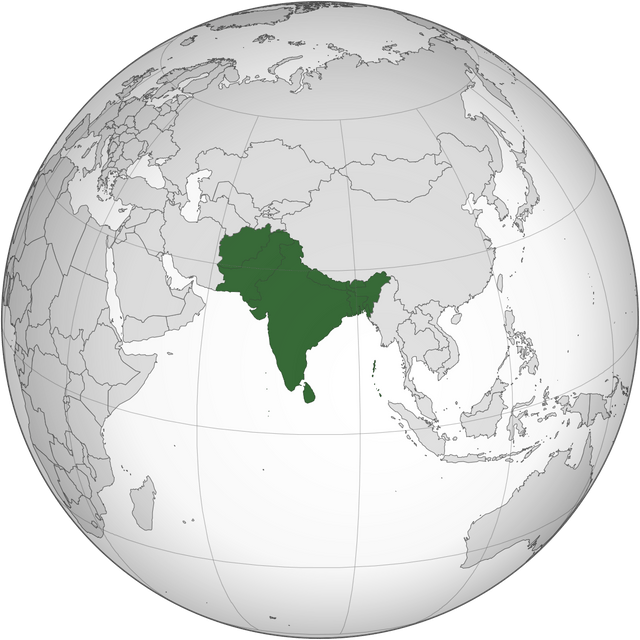
South Asia

| Area | 5,134,641 km2(1,982,496 sq mi) |
|---|---|
| Population | 1,814,014,121 (2018) (1st)[6] |
| Population density | 362.3/km2(938/sq mi) |
| GDP (nominal) | $3.461 trillion (2018)[7] |
| GDP (PPP) | $12.752 trillion (2018)[7] |
| GDP per capita | $1,908 (nominal)[7] $7,029 (PPP)[7] |
| HDI | |
| Ethnic groups | Indo-Aryan, Dravidian, Sino-Tibetan, Austroasiatic, Iranian, etc. |
| Religions | Hinduism, Islam, Buddhism, Sikhism, Christianity, Jainism, Zoroastrianism |
| Demonym | South Asian |
| Countries | |
| Dependencies |
|
| Languages | Other languages
|
| Time zones | 5 time zones
|
| Internet TLD | .af, .bd, .bt, .in, .lk, .mv, .np, .pk |
| Calling code | Zone 8 & 9 |
| Largest cities | [1] |
| UN M49 code | 034– Southern Asia142– Asia001– World |
South Asia, or Southern Asia, is the southern region of the Asian continent, which comprises the sub-Himalayan SAARC countries and, for some authorities, adjoining countries to the west and east. Topographically, it is dominated by the Indian Plate, which rises above sea level as Nepal and northern parts of India situated south of the Himalayas and the Hindu Kush. South Asia is bounded on the south by the Indian Ocean and on land (clockwise, from west) by West Asia, Central Asia, East Asia, and Southeast Asia.
The current territories of Afghanistan, Bangladesh, Bhutan, Maldives, Nepal, India, Pakistan, and Sri Lanka form South Asia.[8] The South Asian Association for Regional Cooperation (SAARC) is an economic cooperation organisation in the region which was established in 1985 and includes all eight nations comprising South Asia.[9]
South Asia covers about 5.2 million km2 (2 million mi2), which is 11.71% of the Asian continent or 3.5% of the world's land surface area.[8] The population of South Asia is about 1.891 billion or about one fourth of the world's population, making it both the most populous and the most densely populated geographical region in the world.[10] Overall, it accounts for about 39.49% of Asia's population, over 24% of the world's population, and is home to a vast array of people.[11][12][13]
In 2010, South Asia had the world's largest population of Hindus, Jains and Sikhs. It alone accounted for 98.47% population of global Hindus and 90.5% of global Sikhs. It also has the largest population of Muslims in the Asia-Pacific region which forms one third global Muslim population[14][15] as well as over 35 million Christians and 25 million Buddhists.[16]
| Area | 5,134,641 km2(1,982,496 sq mi) |
|---|---|
| Population | 1,814,014,121 (2018) (1st)[6] |
| Population density | 362.3/km2(938/sq mi) |
| GDP (nominal) | $3.461 trillion (2018)[7] |
| GDP (PPP) | $12.752 trillion (2018)[7] |
| GDP per capita | $1,908 (nominal)[7] $7,029 (PPP)[7] |
| HDI | |
| Ethnic groups | Indo-Aryan, Dravidian, Sino-Tibetan, Austroasiatic, Iranian, etc. |
| Religions | Hinduism, Islam, Buddhism, Sikhism, Christianity, Jainism, Zoroastrianism |
| Demonym | South Asian |
| Countries | |
| Dependencies |
|
| Languages | Other languages
|
| Time zones | 5 time zones
|
| Internet TLD | .af, .bd, .bt, .in, .lk, .mv, .np, .pk |
| Calling code | Zone 8 & 9 |
| Largest cities | [1] |
| UN M49 code | 034– Southern Asia142– Asia001– World |
Definitions
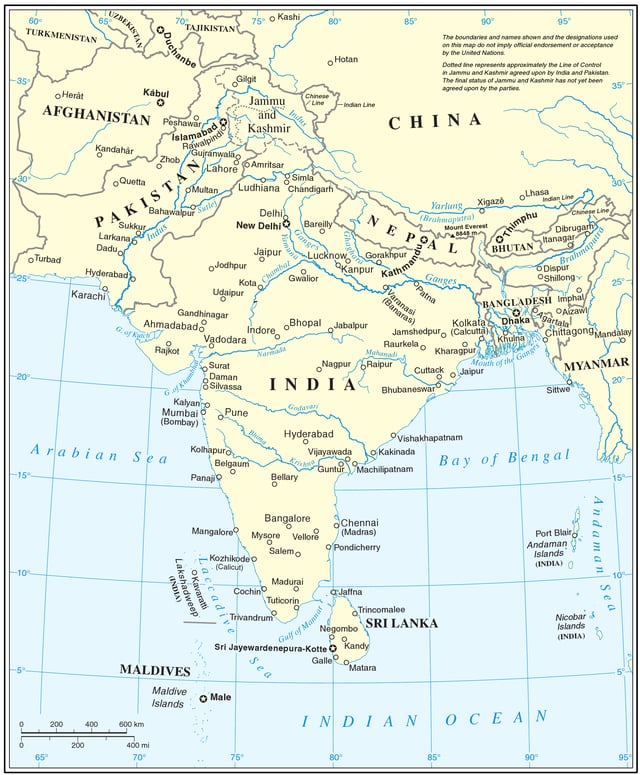
United Nations cartographic map of South Asia.[17] However, the United Nations does not endorse any definitions or area boundaries.[2]
The total area of South Asia and its geographical extent is not clear cut as systemic and foreign policy orientations of its constituents are quite asymmetrical.[18] Aside from the central region of South Asia, formerly part of the British Empire, there is a high degree of variation as to which other countries are included in South Asia.[19][20][21][22]
Modern definitions of South Asia are consistent in including Afghanistan, India, Pakistan, Bangladesh, Sri Lanka, Nepal, Bhutan and Maldives as the constituent countries.[23][24][25][26][27][28] Myanmar is included by some scholars in South Asia, but in Southeast Asia by others.[20][29] Some do not include Afghanistan,[20] others question whether Afghanistan should be considered a part of South Asia or the Middle East.[30][31]
The current territories of Bangladesh, India, and Pakistan, which were the core of the British Empire from 1857 to 1947, form the central region of South Asia, in addition to Afghanistan,[23][24][25][26][27][28] which was a British protectorate until 1919, after the Second Anglo-Afghan war. The mountain countries of Nepal and Bhutan, and the island countries of Sri Lanka and Maldives are generally included as well. Myanmar (formerly Burma) is often added, and by various deviating definitions based on often substantially different reasons, the British Indian Ocean Territory and the Tibet Autonomous Region are included as well.[18][32][33][34][35][36][37][38][39]
The common concept of South Asia is largely inherited from the administrative boundaries of the British Raj,[40] with several exceptions. The Aden Colony, British Somaliland and Singapore, though administered at various times under the Raj, have not been proposed as any part of South Asia.[41] Additionally Burma was administered as part of the Raj until 1937, but is now considered a part of Southeast Asia and is a member state of ASEAN. The 562 princely states that were protected by but not directly ruled by the Raj became administrative parts of South Asia upon joining Union of India or Dominion of Pakistan.[42][43][44] Geopolitically, it had formed the whole territory of Greater India,[29][45]
The South Asian Association for Regional Cooperation (SAARC), a contiguous block of countries, started in 1985 with seven countries – Bangladesh, Bhutan, India, the Maldives, Nepal, Pakistan and Sri Lanka – and added Afghanistan as an eighth member in 2007.[46][47] China and Myanmar have also applied for the status of full members of SAARC.[48][49] This bloc of countries include two independent countries that were not part of the British Raj – Nepal, and Bhutan. Afghanistan was a British protectorate from 1878 until 1919, after the Afghans lost to the British in the Second Anglo-Afghan war. The World Factbook, based on geo-politics, people, and economy defines South Asia as comprising Afghanistan, Bangladesh, Bhutan, British Indian Ocean Territory, India, Maldives, Nepal, Pakistan, and Sri Lanka.[50] The South Asia Free Trade Agreement incorporated Afghanistan in 2011, and the World Bank grouping of countries in the region also includes all eight members comprising South Asia and SAARC as well,[51][52] and the same goes for the United Nations Children's Fund (UNICEF).[53][54]
Definition by South Asian Studies programs When the Centre for South Asian Studies at the University of Cambridge was established, in 1964, it promoted the study of India, Pakistan, Sri Lanka, Bangladesh, Afghanistan,[55][56][57][58] the Himalayan Kingdoms (Nepal, Bhutan, and Sikkim[59]), and Burma (now Myanmar). It has since included Thailand, Malaysia, Singapore, Vietnam, Cambodia, Laos, Indonesia, the Philippines and Hong Kong.[60] The Centres for South Asian Studies at both the University of Michigan and the University of Virginia include Tibet along with the eight members of SAARC in their research programs, but exclude the Maldives.[61][62] The South Asian Studies Program of Rutgers University and the University of California, Berkeley Centre for South Asia Studies also include the Maldives.[63][64] The South Asian Studies Program of Brandeis University defines the region as comprising "India, Pakistan, Bangladesh, Sri Lanka, Nepal, Bhutan, and in certain contexts Afghanistan, Burma, Maldives and Tibet".[65] The similar program of Columbia University includes Afghanistan, Bangladesh, India, the Maldives, Nepal, Pakistan, and Sri Lanka in their study and excludes Burma.[66]
The United Nations Statistics Division's scheme of sub-regions include all eight members of the SAARC as part of Southern Asia, along with Iran[67] only for statistical purposes.[68] Population Information Network (POPIN) includes Afghanistan, Bangladesh, Burma, India, Nepal, Pakistan and Sri Lanka as part of South Asia. Maldives, in view of its characteristics, was admitted as a member Pacific POPIN subregional network only in principle.[69] The Hirschman–Herfindahl index of the United Nations Economic and Social Commission for Asia and the Pacific for the region includes only the original seven signatories of SAARC.[70]
The British Indian Ocean Territory is connected to the region by a publication of Jane's for security considerations.[71] The region may also include the disputed territory of Aksai Chin, which was part of the British Indian princely state of Jammu and Kashmir, but is now administered as part of the Chinese autonomous region of Xinjiang.[72]
The inclusion of Myanmar in South Asia is without consensus, with many considering it a part of Southeast Asia and others including it within South Asia.[20][29] Afghanistan was of importance to the British colonial empire, especially after the Second Anglo-Afghan War over 1878–1880. Afghanistan remained a British protectorate until 1919, when a treaty with Vladimir Lenin included the granting of independence to Afghanistan. Following India's partition, Afghanistan has generally been included in South Asia, with some considering it a part of Southwest Asia.[18] During the Soviet–Afghan War (1979–1989) American foreign policy considered Pakistan and Afghanistan in Southwest Asia, while others included it as a part of South Asia.[8] There is no universal agreement among scholars on which countries should be included within South Asia.[20]
In the past, a lack of a coherent definition for South Asia resulted in not only a lack of academic studies, but also in a lack interest for such studies.[73] The confusion existed also because of the lack of a clear boundary – geographically, geopolitical, socio-culturally, economically or historically – between South Asia and other parts of Asia, especially the Middle East and Southeast Asia.[74] Identification with a South Asian identity was also found to be significantly low among respondents in an older two-year survey across Bangladesh, India, Nepal, Pakistan, and Sri Lanka.[75] However, modern definitions of South Asia are very consistent in including Afghanistan, India, Pakistan, Bangladesh, Sri Lanka, Nepal, Bhutan and Maldives as the constituent countries.[23][24][25][26][27][28]
Indian subcontinent
According to the Oxford English Dictionary, the term "subcontinent" signifies a "subdivision of a continent which has a distinct geographical, political, or cultural identity" and also a "large land mass somewhat smaller than a continent".[76][77] Historians Catherine Asher and Cynthia Talbot state that the term "Indian subcontinent" describes a natural physical landmass in South Asia that has been relatively isolated from the rest of Eurasia.[78] The Indian subcontinent is also a geological term referring to the land mass that drifted northeastwards from ancient Gondwana, colliding with the Eurasian plate nearly 55 million years ago, towards the end of Palaeocene. This geological region largely includes Bangladesh, Bhutan, India, Maldives, Nepal, Pakistan and Sri Lanka.[79]
According to anthropologist John R. Lukacs, "the Indian Subcontinent occupies the major landmass of South Asia",[81] while the political science professor Tatu Vanhanen states, "the seven countries of South Asia constitute geographically a compact region around the Indian Subcontinent".[82] According to Chris Brewster, India, Pakistan, Bangladesh, Sri Lanka, Nepal and Bhutan constitute the Indian subcontinent; with Afghanistan and Maldives included it is more commonly referred to as South Asia.[83] The geopolitical boundaries of Indian subcontinent, according to Dhavendra Kumar, include "India, Pakistan, Bangladesh, Sri Lanka, Nepal, Bhutan and other small islands of the Indian Ocean".[84] Maldives, the country consisting of a small archipelago southwest of the peninsula, is considered part of the Indian subcontinent.[85]
The terms "Indian subcontinent" and "South Asia" are sometimes used interchangeably.[32][80] The South Asia term is particularly common when scholars or officials seek to differentiate this region from East Asia.[86] According to historians Sugata Bose and Ayesha Jalal, the Indian subcontinent has come to be known as South Asia "in more recent and neutral parlance."[87] This "neutral" notion refers to the concerns of Pakistan and Bangladesh, particularly given the recurring conflicts between India and Pakistan, wherein the dominant placement of "India" as a prefix before the subcontinent might offend some political sentiments.[29]
There is no globally accepted definition on which countries are a part of South Asia or Indian subcontinent.[20][21][22] While Afghanistan is not considered as a part of the Indian subcontinent, Afghanistan is often included in South Asia.[22] Similarly, Myanmar is included by some scholars in South Asia but not in Indian subcontinent.[29]
History
Ancient era
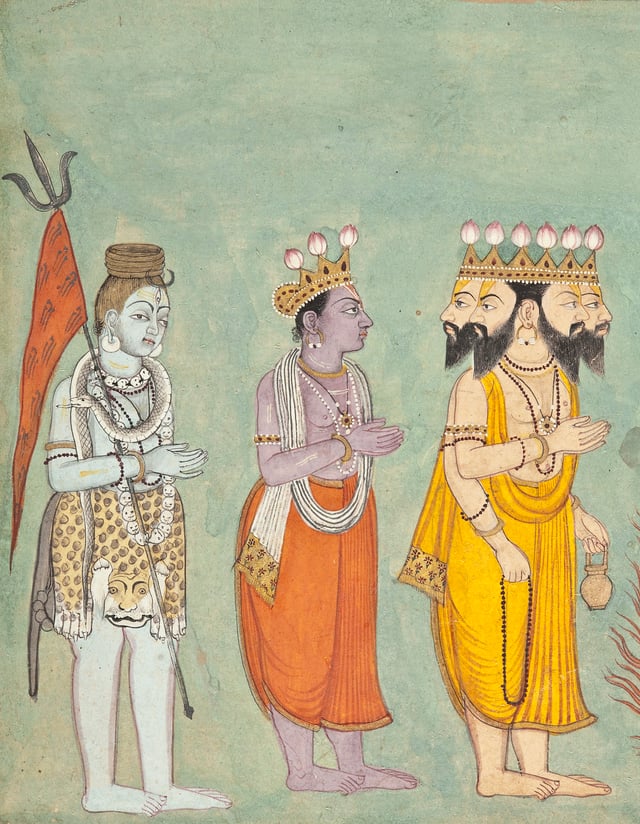
The Trimurti is the trinity of supreme divinity in Hinduism, typically Brahma the creator, Vishnu the preserver, and Shiva the destroyer
The history of core South Asia begins with evidence of human activity of Homo sapiens, as long as 75,000 years ago, or with earlier hominids including Homo erectus from about 500,000 years ago.[88] The Indus Valley Civilization, which spread and flourished in the northwestern part of South Asia from c. 3300 to 1300 BCE in present-day Pakistan, India and Afghanistan, was the first major civilization in South Asia.[89] A sophisticated and technologically advanced urban culture developed in the Mature Harappan period, from 2600 to 1900 BCE.[90]
The earliest prehistoric culture have roots in the mesolithic sites as evidenced by the rock paintings of Bhimbetka rock shelters dating to a period of 30,000 BCE or older,[3] as well as neolithic times.[4] According to anthropologist Possehl, the Indus Valley Civilization provides a logical, if somewhat arbitrary, starting point for South Asian religions, but these links from the Indus religion to later-day South Asian traditions are subject to scholarly dispute.[91]
The Vedic period, named after the Vedic religion of the Indo-Aryans,[5] lasted from c. 1900 to 500 BCE.[93][94] The Indo-Aryans were pastoralists[95] who migrated into north-western India after the collapse of the Indus Valley Civilization,[92][96] Linguistic and archaeological data show a cultural change after 1500 BCE,[92] with the linguistic and religious data clearly showing links with Indo-European languages and religion.[97] By about 1200 BCE, the Vedic culture and agrarian lifestyle was established in the northwest and northern Gangetic plain of South Asia.[95][98][99] Rudimentary state-forms appeared, of which the Kuru-Pañcāla union was the most influential.[100][101] The first recorded state-level society in South Asia existed around 1000 BCE.[95] In this period, states Samuel, emerged the Brahmana and Aranyaka layers of Vedic texts, which merged into the earliest Upanishads.[102] These texts began to ask the meaning of a ritual, adding increasing levels of philosophical and metaphysical speculation,[102] or "Hindu synthesis".[103]
Increasing urbanisation of India between 800 and 400 BCE, and possibly the spread of urban diseases, contributed to the rise of ascetic movements and of new ideas which challenged the orthodox Brahmanism.[104] These ideas led to Sramana movements, of which Mahavira (c. 549–477 BCE), proponent of Jainism, and Buddha (c. 563-483), founder of Buddhism, were the most prominent icons.[105]
The Greek army led by Alexander the Great stayed in the Hindu Kush region of South Asia for several years and then later moved into the Indus valley region. Later, the Maurya Empire extended over much of South Asia in the 3rd century BCE. Buddhism spread beyond south Asia, through northwest into Central Asia. The Bamiyan Buddhas of Afghanistan and the edicts of Aśoka suggest that the Buddhist monks spread Buddhism (Dharma) in eastern provinces of the Seleucid Empire, and possibly even farther into West Asia.[106][107][108] The Theravada school spread south from India in the 3rd century BCE, to Sri Lanka, later to Southeast Asia.[109] Buddhism, by the last centuries of the 1st millennium BCE, was prominent in the Himalayan region, Gandhara, Hindu Kush region and Bactria.[110][111][112]
From about 500 BCE through about 300 CE, the Vedic-Brahmanic synthesis or "Hindu synthesis" continued.[103] Classical Hindu and Sramanic (particularly Buddhist) ideas spread within South Asia, as well outside South Asia.[113][114][115] The Gupta Empire ruled over a large part of the region between 4th and 7th centuries, a period that saw the construction of major temples, monasteries and universities such as the Nalanda.[116][117][118] During this era, and through the 10th century, numerous cave monasteries and temples such as the Ajanta Caves, Badami cave temples and Ellora Caves were built in South Asia.[119][120][121]
Medieval era
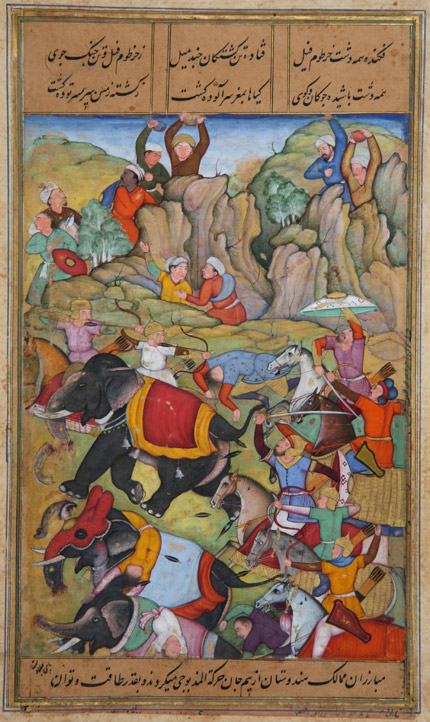
Turco-Mongol conqueror Timur defeats the Sultan of Delhi, Nasir-u Din Mehmud, in the winter of 1397–1398
Islam came as a political power in the fringe of South Asia in 8th century CE when the Arab general Muhammad bin Qasim conquered Sindh and Multan in southern Punjab in modern-day Pakistan.[122] By 962 CE, Hindu and Buddhist kingdoms in South Asia were under a wave of raids from Muslim armies from Central Asia.[123] Among them was Mahmud of Ghazni, who raided and plundered kingdoms in north India from east of the Indus river to west of Yamuna river seventeen times between 997 and 1030.[124] Mahmud of Ghazni raided the treasuries but retracted each time, only extending Islamic rule into western Punjab.[125][126]
The wave of raids on north Indian and western Indian kingdoms by Muslim warlords continued after Mahmud of Ghazni, plundering and looting these kingdoms.[127] The raids did not establish or extend permanent boundaries of their Islamic kingdoms. The Ghurid Sultan Mu'izz al-Din Muhammad began a systematic war of expansion into North India in 1173.[128] He sought to carve out a principality for himself by expanding the Islamic world.[124][129] Mu'izz sought a Sunni Islamic kingdom of his own extending east of the Indus river, and he thus laid the foundation for the Muslim kingdom that became the Delhi Sultanate.[124] Some historians chronicle the Delhi Sultanate from 1192 due to the presence and geographical claims of Mu'izz al-Din in South Asia by that time.[130] The Delhi Sultanate covered varying parts of South Asia, and was ruled by a series of dynasties, called Mamluk, Khalji, Tughlaq, Sayyid and Lodi dynasties. Muhammad bin Tughlaq came to power in 1325, launched a war of expansion and the Delhi Sultanate reached it largest geographical reach over the South Asian region during his 26-year rule.[131] A Sunni Sultan, Muhammad bin Tughlaq persecuted non-Muslims such as Hindus, as well as non-Sunni Muslims such as Shia and Mahdi sects.[132][133][134]
Revolts against the Delhi Sultanate sprang up in many parts of South Asia during the 14th century. After the death of Muhammad bin Tughlaq, the Bengal Sultanate came to power in 1352 CE, as the Delhi Sultanate began disintegrating. The Bengal Sultanate remained in power through the early 16th century. It was reconquered by the armies of the Mughal Empire. The state religion of the Bengal Sultanate was Islam, and the region under its rule, a region that ultimately emerged as the modern nation of Bangladesh, saw a growth of a syncretic form of Islam.[135][136] In the Deccan region, the Hindu kingdom Vijayanagara Empire came to power in 1336 and remained in power through the 16th century, after which it too was reconquered and absorbed into the Mughal Empire.[137][138]
About 1526, the Punjab governor Dawlat Khan Lodī reached out to the Mughal Babur and invited him to attack Delhi Sultanate. Babur defeated and killed Ibrahim Lodi in the Battle of Panipat in 1526. The death of Ibrahim Lodi ended the Delhi Sultanate, and the Mughal Empire replaced it.[139]
Modern era
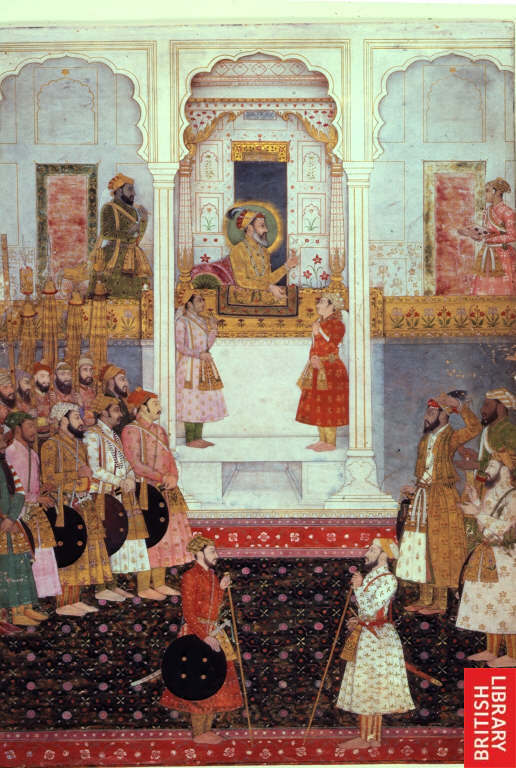
Emperor Shah Jahan and Prince Aurangzeb in Mughal Court, 1650
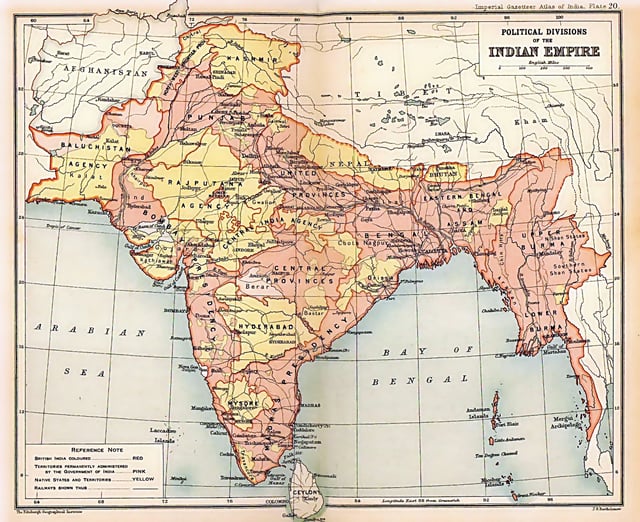
British Indian Empire in 1909. British India is shaded pink, the princely states yellow.
The modern history period of South Asia, that is 16th-century onwards, witnessed the start of the Central Asian dynasty named the Mughals, with Turkish-Mongol roots and Sunni Islam theology. The first ruler was Babur, whose empire extended the northwest and Indo-Gangetic Plain regions of South Asia. The Deccan and northeastern region of the South Asia was largely under Hindu kings such as those of Vijayanagara Empire and Ahom kingdom,[140] with some regions such as parts of modern Telangana and Andhra Pradesh under local Sultanates such as the Shia Islamic rulers of Golconda Sultanate.[141]
The Mughal Empire continued its wars of expansion after Babur's death. With the fall of the Rajput kingdoms and Vijayanagara, its boundaries encompassed almost the entirety of the Indian subcontinent.[142] The Mughal Empire was marked by a period of artistic exchanges and a Central Asian and South Asian architecture synthesis, with remarkable buildings such as the Taj Mahal.[143] At its height, the empire was the world's largest economy, worth almost 25% of global GDP, more than the entirety of Western Europe.[144][145]
However, this time also marked an extended period of religious persecution.[146] Two of the religious leaders of Sikhism, Guru Arjan and Guru Tegh Bahadur were arrested under orders of the Mughal emperors, asked to convert to Islam, and executed when they refused.[147][148][149] Religious taxes on non-Muslims called jizya were imposed. Buddhist, Hindu and Sikh temples were desecrated. However, not all Muslim rulers persecuted non-Muslims. Akbar, a Mughal ruler for example, sought religious tolerance and abolished jizya.[150][151][152][153]
In Aurangzeb's time, almost all of South Asia was claimed by the Mughal Empire. Through Aurangzeb's Islamic Sharia based rule, South Asia reached its zenith, becoming the world's largest economy and biggest manufacturing power, estimated over 25% of world GDP, a value higher than China's and the entire Western Europe's one.[144][145]
The economic developments on South Asia waved the period of proto-industrialization.[154]
Maritime trading between South Asia and European merchants began after the Portuguese explorer Vasco de Gama returned to Europe. British, French, Portuguese colonial interests struck treaties with these rulers, and established their trading ports. In northwest South Asia, a large region was consolidated into the Sikh Empire by Ranjit Singh.[157][158] After the defeat of the Nawab of Bengal and Tipu Sultan and his French allies, the British Empire expanded their interests till the Hindu Kush region. In the east, the Bengal region was split into Muslim East Bengal and Hindu West Bengal, by the colonial British empire, in early 1900s, a split that was reversed. However, after the World War II, at the eve of India's independence, the region was split again into East Pakistan and West Bengal. East Pakistan became Bangladesh in 1971.[159][160]
Geography
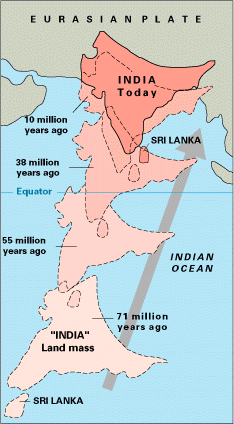
The Indian peninsula, and the Himalayas on the northeast, is the result of the collision of the Indian Plate with the Eurasian Plate through tectonic activity between 20 and 50 million years ago.
According to Saul Cohen, early colonial era strategists treated South Asia with East Asia, but in reality the South Asia region excluding Afghanistan is a distinct geopolitical region separated from other nearby geostrategic realms, one that is geographically diverse.[161] The region is home to a variety of geographical features, such as glaciers, rainforests, valleys, deserts, and grasslands that are typical of much larger continents. It is surrounded by three water bodies – the Bay of Bengal, the Indian Ocean and the Arabian Sea – and has acutely varied climate zones. The tip of the Indian Peninsula had the highest quality pearls.[162]
Boundary
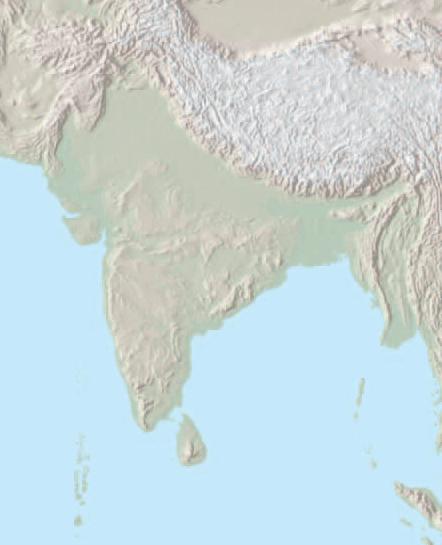
While South Asia had never been a coherent geopolitical region, it has a distinct geographical identity
The boundaries of South Asia vary based on how the region is defined. South Asia's northern, eastern, and western boundaries vary based on definitions used, while the Indian Ocean is the southern periphery. Most of this region rests on the Indian Plate and is isolated from the rest of Asia by mountain barriers.[163][164] Much of the region consists of a peninsula in south-central Asia, rather resembling a diamond which is delineated by the Himalayas on the north, the Hindu Kush in the west, and the Arakanese in the east,[165] and which extends southward into the Indian Ocean with the Arabian Sea to the southwest and the Bay of Bengal to the southeast.[32][34]
According to Robert M. Cutler – a scholar of Political Science at Carleton University,[166] the terms South Asia, Southwest Asia and Central Asia are distinct, but the confusion and disagreements have arisen due to the geopolitical movement to enlarge these regions into Greater South Asia, Greater Southwest Asia and Greater Central Asia. The frontier of Greater South Asia, states Cutler, between 2001–2006 has been geopolitically extended to eastern Iran and western Afghanistan in the west, and in the north to northeastern Iran, northern Afghanistan, and southern Uzbekistan.[166]
Indian plate
Most of this region is resting on the Indian Plate, the northerly portion of the Indo-Australian Plate, separated from the rest of the Eurasian Plate. The Indian Plate includes most of South Asia, forming a land mass which extends from the Himalayas into a portion of the basin under the Indian Ocean, including parts of South China and Eastern Indonesia, as well as Kunlun and Karakoram ranges,[167][168] and extending up to but not including Ladakh, Kohistan, the Hindu Kush range and Balochistan.[169][170][171] It may be noted that geophysically the Yarlung Tsangpo River in Tibet is situated at the outside of the border of the regional structure, while the Pamir Mountains in Tajikistan are situated inside that border.[172]
It was once a small continent before colliding with the Eurasian Plate about 50–55 million years ago and giving birth to the Himalayan range and the Tibetan plateau. It is the peninsular region south of the Himalayas and Kuen Lun mountain ranges and east of the Indus River and the Iranian Plateau, extending southward into the Indian Ocean between the Arabian Sea (to the southwest) and the Bay of Bengal (to the southeast).
Climate

South Asia's Köppen climate classification map[173] is based on native vegetation, temperature, precipitation and their seasonality. (Af) Tropical rainforest (Am) Tropical monsoon (Aw) Tropical savanna, wet & dry (BWh) Hot desert (BWk) Cold desert (BSh) Hot semi arid (BSk) Cold semi arid (Csa) Mediterranean, dry, hot summer (Cfa) Subtropical, humid (Cwa) Subtropical, humid summer, dry winter (Cwb) Subtropical highland, dry winter (Dsa) Continental, hot summer (Dsb) Continental, warm summer (Dwb) Continental, dry winter (Dwc) Continental Subarctic, dry winter
The climate of this vast region varies considerably from area to area from tropical monsoon in the south to temperate in the north. The variety is influenced by not only the altitude, but also by factors such as proximity to the sea coast and the seasonal impact of the monsoons. Southern parts are mostly hot in summers and receive rain during monsoon periods. The northern belt of Indo-Gangetic plains also is hot in summer, but cooler in winter. The mountainous north is colder and receives snowfall at higher altitudes of Himalayan ranges.
As the Himalayas block the north-Asian bitter cold winds, the temperatures are considerably moderate in the plains down below. For most part, the climate of the region is called the Monsoon climate, which keeps the region humid during summer and dry during winter, and favours the cultivation of jute, tea, rice, and various vegetables in this region.
South Asia is largely divided into four broad climate zones:[174]
The northern Indian edge and northern Pakistani uplands have a dry subtropical continental climate
The far south of India and southwest Sri Lanka have a equatorial climate
Most of the peninsula have a tropical climate with variations: Hot subtropical climate in northwest India Cool winter hot tropical climate in Bangladesh Tropical semi-arid climate in the center
The Himalayas have an Alpine climate
Maximum relative humidity of over 80% has been recorded in Khasi and Jaintia Hills and Sri Lanka, while the area adjustment to Pakistan and western India records lower than 20%–30%.[174] Climate of South Asia is largely characterized by monsoons. South Asia depends critically on monsoon rainfall.[175] Two monsoon systems exist in the region:[176]
The summer monsoon: Wind blows from southwest to most of parts of the region. It accounts for 70%–90% of the annual precipitation.
The winter monsoon: Wind blows from northeast. Dominant in Sri Lanka and Maldives.
The warmest period of the year precedes the monsoon season (March to mid June). In the summer the low pressures are centered over the Indus-Gangetic Plain and high wind from the Indian Ocean blows towards the center. The monsoons are second coolest season of the year because of high humidity and cloud covering. But, at the beginning of June the jetstreams vanish above the Tibetan Plateau, low pressure over the Indus Valley deepens and the Intertropical Convergence Zone (ITCZ) moves in. The change is violent. Moderately vigorous monsoon depressions form in the Bay of Bengal and make landfall from June to September.[174]
Statistical data
Below is the latest general statistical data for South Asian nations. Their total population, area and GDPs have been cited along with their shares of percentage of this attribute of total South Asia in bracket. Republic of India accounts for most of landmass, population and GDP and hence, heavily influences average of South Asian development attributes. Sri Lanka and Maldives are leaders in the region in terms of Human Development Index and GDP per capita while Afghanistan scores lowest in terms of both the attributes in the region.
| Country [177][177][178][179] | Capital [179][180][181] | Area (km2) (%Share) [182] | Population in thousands (2019) (%Share)[183][184] | Density (per km2) | Nominal GDP (in millions) (2019) (%Share)[185][186][187] | GDP per capita(2019)[188] | GDP (PPP) (in millions) (2019) (%Share) | GDP (PPP) per capita (2019) | HDI(2017)[189] |
|---|---|---|---|---|---|---|---|---|---|
| ** | Kabul | 652,230 (12.7%) | 38,042 (2.07%) | 58.3 | $19,990 (0.54%) | $577 | $76,714 (0.55%) | $2,101 | |
| ** | Dhaka | 147,570 (2.87%) | 163,046 (8.88%) | 1,104.9 | $314,656 (8.49%) | $1,925 | $829,270 (5.92%) | $4,992 | |
| ** | Thimphu | 38,394 (0.75%) | 763 (0.04%) | 19.8 | $2,840 (0.07%) | $3,672 | $9,310 (0.066%) | $10,193 | |
| ** | New Delhi | 3,287,263 (64.02%) | 1,366,418 (74.45%) | 415.6 | $2,971,996 (80.19%) | $2,198 | $11436,697 (81.68%) | $8,484 | |
| ** | Malé | 298 (0.006%) | 531 (0.03%) | 1,781.8 | $5,749 (0.16%) | $13,875 | $6,708 (0.048%) | $21,320 | |
| ** | Kathmandu | 147,181 (2.87%) | 28,609 (1.56%) | 194.3 | $28,922 (0.78%) | $934 | $87,472 (0.62%) | $2,984 | |
| ** | Islamabad | 796,095 (15.5%) | 216,565 (11.8%) | 245.8 | $278,019 (7.74%) | $1,357 | $1,235,663 (8.82%) | $5,839 | |
| ** | Colombo | 65,610 (1.28%) | 21,324 (1.62%) | 325 | $84,164 (2.27%) | $4,336 | $319,791 (2.28%) | $14,680 | |
| South Asia | 5,134,641 (100%) | 1,835,297 (100%) | 357.4 | $3,706,337 (100%) | $2,019 | $14,001, 625 (100%) | $7,629 | ||
Population projections
Population of South Asian countries in 1950, 1975, 2000, 2025, 2050, 2075 and 2100 projection from the United Nations. The population projections use medium fertility index. With India and Bangladesh approaching replacement rates fast, population growth in South Asia is facing steep decline and may turn negative in mid 21st century. Population is given in thousands.[183][184]
| Rank | Country | 1950 | 1975 | 2000 | 2025 | 2050 | 2075 | 2100 |
|---|---|---|---|---|---|---|---|---|
| 1 | 376,325 | 623,103 | 1,056,576 | 1,445,012 | 1,639,176 | 1,609,041 | 1,450,421 | |
| 2 | 37,542 | 66,817 | 142,344 | 242,234 | 338,013 | 394,265 | 403,103 | |
| 3 | 37,895 | 70,066 | 127,658 | 170,937 | 192,568 | 181,282 | 151,393 | |
| 4 | 7,752 | 12,689 | 20,780 | 43, 532 | 64,683 | 76,199 | 74,938 | |
| 5 | 8,483 | 13,420 | 23,941 | 31,757 | 35,324 | 31,818 | 23,708 | |
| 6 | 7,971 | 13,755 | 18,778 | 21,780 | 21,814 | 19,194 | 15,275 | |
| 7 | 177 | 348 | 591 | 811 | 905 | 845 | 686 | |
| 8 | 74 | 136 | 279 | 522 | 586 | 564 | 490 | |
| Total | 476,220 | 800,335 | 1,390,946 | 1,958,046 | 2,293,069 | 2,313,27 | 2,120,014 | |
Land and water area
This list includes dependent territories within their sovereign states (including uninhabited territories), but does not include claims on Antarctica. EEZ+TIA is exclusive economic zone (EEZ) plus total internal area (TIA) which includes land and internal waters.
| Rank | Country | Area | EEZ | Shelf | EEZ+TIA |
|---|---|---|---|---|---|
| 1 | 3,287,263 | 2,305,143 | 402,996 | 5,592,406 | |
| 2 | 881,913 | 290,000 | 51,383 | 1,117,911 | |
| 3 | 652,864 | 0 | 0 | 652,864 | |
| 4 | 147,570 | 86,392 | 66,438 | 230,390 | |
| 5 | 147,181 | 0 | 0 | 147,181 | |
| 6 | 65,610 | 532,619 | 32,453 | 598,229 | |
| 7 | 38,394 | 0 | 0 | 38,394 | |
| 8 | 298 | 923,322 | 34,538 | 923,622 | |
| Total | 5,221,093 | 4,137,476 | 587,808 | 9,300,997 | |
Regional groups of countries
| Name of country/region, with flag | Area (km2) | Population | Population density (per km2) | Capital or Secretariat | Currency | Countries included | Official languages | Coat of Arms |
|---|---|---|---|---|---|---|---|---|
| Core Definition (above) of South Asia | 5,220,460 | 1,726,907,000 | 330.79 | N/A | N/A | Afghanistan, Bangladesh, Bhutan, India, Maldives, Nepal, Pakistan, Sri Lanka | N/A | N/A |
| UNSD of South Asia | 6,778,083 | 1,702,000,000 | 270.77 | N/A | N/A | Afghanistan, Bangladesh, Bhutan, India, Iran, Maldives, Nepal, Pakistan, Sri Lanka | N/A | N/A |
| SAARC | 4,637,469 | 1,626,000,000 | 350.6 | Kathmandu | N/A | Afghanistan, Bangladesh, Bhutan, India, Maldives, Nepal, Pakistan, Sri Lanka | English | N/A |
| BBIN | 3,499,559 | 1,465,236,000 | 418.69 | N/A | N/A | Bangladesh, Bhutan, India, Nepal | N/A | N/A |
| SASEC | 3,565,467 | 1,485,909,931 | 416.75 | N/A | N/A | Bangladesh, Bhutan, India, Nepal, Sri Lanka, Maldives | N/A | N/A |
Demographics
Largest urban areas
| Rank | City | Province/State | Country | Population[192] | Area (km2)[192] | Density (/km2)[192] | Classification |
|---|---|---|---|---|---|---|---|
| 1 | Delhi | National Capital Region | 29,399,141 | 2,072 | 12,100 | Capital region | |
| 2 | Dhaka | Dhaka Division | 20,283,552 | 360 | 43,500 | Capital city | |
| 3 | Mumbai | Maharashtra | 20,185,064 | 546 | 32,400 | Megacity | |
| 4 | Karachi | Sindh | 15,741,406 | 945 | 23,400 | Metropolis | |
| 5 | Kolkata | West Bengal | 14,667,000 | 1,204 | 12,200 | Megacity | |
| 6 | Lahore | Punjab | 12,414,000 | 790 | 12,700 | Megacity | |
| 7 | Bengaluru | Karnataka | 10,248,000 | 1,116 | 8,400 | Megacity | |
| 8 | Chennai | Tamil Nadu | 9,714,000 | 375 | 25,900 | Metropolis | |
| 9 | Hyderabad | Telangana | 8,754,000 | 971 | 10,000 | Metropolis | |
| 10 | Ahmedabad | Gujarat | 7,186,000 | 464 | 20,600 | Metropolis |
Languages
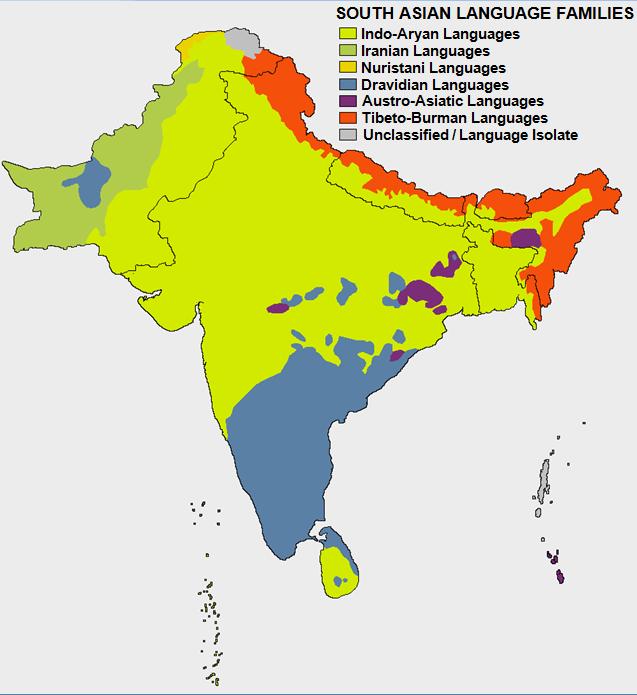
Ethno-linguistic distribution map of South Asia.
There are numerous languages in South Asia. The spoken languages of the region are largely based on geography and shared across religious boundaries, but the written script is sharply divided by religious boundaries. In particular, Muslims of South Asia such as in Afghanistan and Pakistan use the Arabic alphabet and Persian Nastaliq. Till 1971, Muslim Bangladesh (then known as East Pakistan) too mandated only the Nastaliq script, but thereafter has adopted regional scripts and particularly Bengali. Non-Muslims of South Asia, and some Muslims in India, on the other hand use their traditional ancient heritage scripts such as those derived from Brahmi script for Indo-European languages and non-Brahmi scripts for Dravidian languages and others.[193]
The Nagari script has been the primus inter pares of the traditional South Asian scripts.[194] The Devanagari script is used for over 120 South Asian languages,[195] including Hindi,[196] Marathi, Nepali, Pali, Konkani, Bodo, Sindhi and Maithili among other languages and dialects, making it one of the most used and adopted writing systems in the world.[197] The Devanagari script is also used for classical Sanskrit texts.[195]
The largest spoken language in this region is Hindi, followed by Bengali, Tamil, Telugu, Marathi, Gujarati and Punjabi.[193] In the modern era, new syncretic languages developed in the region such as Urdu that is used by Muslim community of northern south Asia (particularly Pakistan and northern states of India).[198] The Punjabi language spans three religions: Islam, Hinduism and Sikhism. The spoken language is similar, but it is written in three scripts. The Sikh use Gurmukhi alphabet, Muslim Punjabis in Pakistan use the Nastaliq script, while Hindu Punjabis in India use the Gurmukhi or Nāgarī script. The Gurmukhi and Nagari scripts are distinct but close in their structure, but the Persian Nastaliq script is very different.[199]
English, with British spelling, is commonly used in urban areas and is a major economic lingua franca of South Asia.[200]
Religions
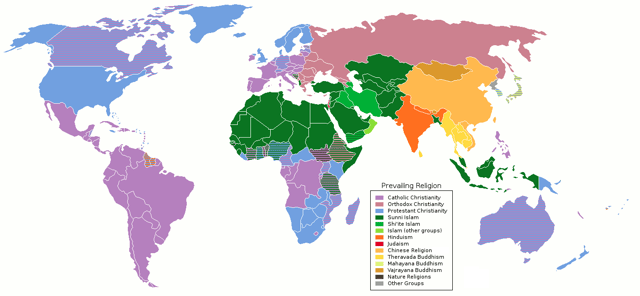
A map of major denominations and religions of the world
In 2010, South Asia had the world's largest population of Hindus, Jains and Sikhs,[14] about 510 million Muslims,[14] as well as over 25 million Buddhists and 35 million Christians.[16] Hindus make up about 68 percent or about 900 million and Muslims at 31 percent or 510 million of the overall South Asia population,[201] while Buddhists, Jains, Christians and Sikhs constitute most of the rest. The Hindus, Buddhists, Jains, Sikhs and Christians are concentrated in India, Nepal, Sri Lanka and Bhutan, while the Muslims are concentrated in Afghanistan (99%), Bangladesh (90%), Pakistan (96%) and Maldives (100%).[14]
Indian religions are the religions that originated in the India; namely Hinduism, Jainism, Buddhism and Sikhism.[202] The Indian religions are distinct yet share terminology, concepts, goals and ideas, and from South Asia spread into East Asia and southeast Asia.[202] Early Christianity and Islam were introduced into coastal regions of South Asia by merchants who settled among the local populations. Later Sindh, Balochistan, and parts of the Punjab region saw conquest by the Arab caliphates along with an influx of Muslims from Persia and Central Asia, which resulted in spread of both Shia and Sunni Islam in parts of northwestern region of South Asia. Subsequently, under the influence of Muslim rulers of the Islamic sultanates and the Mughal Empire, Islam spread in South Asia.[203][204] About one-third of the Muslims are from South Asia.[205][206][207]
| Afghanistan[208] | Islam (99%), Hinduism, Sikhism and Christianity (1%) |
| Bangladesh[209] | Islam (90%), Hinduism (9%), Buddhism (0.6%), Christianity (0.3%), Others (0.1%) |
| Bhutan[210][211] | Buddhism (74.8%), Hinduism (22.6%), Indigenous (1.92%), Christianity (0.5%), Islam (0.1%), Other (0.2%) |
| India[210][212] | Hinduism (79.8%), Islam (14.5%), Christianity (2.3%), Sikhism (1.7%), Buddhism (0.7%), Jainism (0.4%), Others (0.9%) |
| Maldives[213] | Sunni Islam (100%) (One must be a Sunni Muslim to be a citizen on the Maldives[214][215]) |
| Nepal[216] | Hinduism (80%), Buddhism (10%), Islam (4.4%), Kirat (3.1%), Christianity (1.4%), Others (0.8%) |
| Pakistan[217] | Islam (96.28%), Hinduism (2%), Christianity (1.59%), Ahmaddiyya (0.22%) |
| Sri Lanka[218] | Buddhism (70.19%), Hinduism (12.61%), Islam (9.71%), Christianity (7.45%). |
Economy
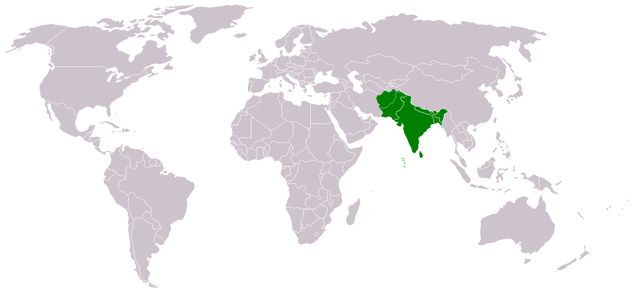
Countries under the South Asian Free Trade Area
India is the largest and fastest growing economy in the region (US$2.957 trillion) and makes up almost 80% of the South Asian economy; it is the world's 6th largest in nominal terms and 3rd largest by purchasing power adjusted exchange rates (US$10.385 trillion).[7] India is the only member of powerful G-20 major economies and BRICS from the region. It is the fastest growing major economy in the world and one of the world's fastest registering a growth of 7.3% in FY 2014–15.
Followed by Bangladesh, which has a GDP of ($314.656 billion) and a GDP per capita of $1888 which is 4th in the region. It has the fastest GDP growth rate in Asia. It is one of the emerging and growth-leading economies of the world and It is also listed among the Next Eleven countries. It is also one of the fastest growing middle-income countries. It has the world's 39th largest GDP in nominal terms and is the 29th largest by purchasing power adjusted exchange rates ($829.272 billion). Bangladesh's economic growth crossed 7% in fiscal 2015–2016 after almost a decade in the region of 6%, It's expected to grow by 8.13% in 2019–2020.
Followed by Pakistan, It has an economy of ($314 billion) and ranks 5th in GDP per capita in the region.[219]
Then by Sri Lanka which has the 2nd highest per capita and is the 4th largest economy in the region. According to a World Bank report in 2015, driven by a strong expansion in India, coupled with favorable oil prices, from the last quarter of 2014 South Asia become the fastest-growing region in the world[220]
The Major Market stock exchanges in the region are Bombay Stock Exchange (BSE) with market Capitalization of $2.298 trillion (11th largest in the world), National Stock Exchange of India (NSE) with market capitalization of $2.273 trillion (12th largest in the world), Dhaka Stock Exchange (DSE) and Pakistan Stock Exchange (PSX) with market capitalization of $72 billion.[221] Economic data is sourced from the International Monetary Fund, current as of April 2017, and is given in US dollars.[222]
| Country [177][177][178][179] | Currency | Population (2016)[223] | Nominal GDP (2017)[185] | GDP per capita(2017)[188] | GDP growth(2017)[224] | Inflation(2017)[225] |
|---|---|---|---|---|---|---|
| ؋ Afghani | 34,656,032 | $21.657 billion | $601 | 3% | 6% | |
| ৳ Bangladeshi Taka | 162,951,560 | $314.656 billion | $1,888 | 7.7% | 5.44% | |
| Nu. Ngultrum | 797,765 | $2.31 billion | $3,215 | 5.9% | 4.1% | |
| ₹ Indian Rupee | 1,324,171,354 | $2.971 trillion | $2,198 | 7.0% | 4.8% | |
| ރ Rufiyaa | 427,756 | $4.825 billion | $14,501 | 4.1% | 2.5% | |
| रु Rupee | 28,982,771 | $27 billion | $919 | 7.7% | 6.2% | |
| ₨ Pakistani Rupee | 193,203,476 | $278.019 billion | $1,357 | 5.2% | 4.3% | |
| රු/ரூ Rupee | 20,798,492 | $92.504 billion | $4,265 | 3.0% | 5.8% |
Health and nutrition
According to WHO, South Asia is home to two out of the three countries in the world still affected by polio, Pakistan and Afghanistan, with 306 & 28 polio cases registered in 2014 respectively.[228] Attempts to eradicate polio have been badly hit by opposition from militants in both countries, who say the program is cover to spy on their operations. Their attacks on immunization teams have claimed 78 lives since December 2012.[229]
According to the World Bank's 2011 report, based on 2005 ICP PPP, about 24.6% of the South Asian population falls below the international poverty line of $1.25/day.[230] Afghanistan and Bangladesh rank the highest, with 30.6% and 43.3% of their respective populations below the poverty line. Bhutan, Maldives and Sri Lanka have the lowest number of people below the poverty line, with 2.4%, 1.5% and 4.1% respectively. India has lifted the most people in the region above the poverty line between 2008 and 2011, around 140 million. As of 2011, 21.9% of India's population lives below the poverty line, compared to 41.6% in 2005.[231][232]
The World Bank estimates that India is one of the highest ranking countries in the world for the number of children suffering from malnutrition. The prevalence of underweight children in India is among the highest in the world, and is nearly double that of Sub Saharan Africa with dire consequences for mobility, mortality, productivity and economic growth.[233]
According to the World Bank, 70% of the South Asian population and about 75% of South Asia's poor live in rural areas and most rely on agriculture for their livelihood[234] according to the UN's Food and Agricultural Organisation. In 2015, approximately 281 million people in the region were malnourished. The report says that Nepal reached both the WFS target as well as MDG and is moving towards bringing down the number of undernourished people to less than 5% of the population.[226] Bangladesh reached the MDG target with the National Food Policy framework – with only 16.5% of the population undernourished. In India, the malnourished comprise just over 15 percent of the population. While the number of malnourished people in neighborhood has shown a decline over the last 25 years, the number of under-nourished in Pakistan displays an upward trend. There were 28.7 million hungry in Pakistan in the 1990s – a number that has steadily increased to 41.3 million in 2015 with 22% of the population malnourished. Approximately 194.6 million people are undernourished in India, which accounts for the highest number of people suffering from hunger in any single country.[226][235]
The 2006 report stated "the low status of women in South Asian countries and their lack of nutritional knowledge are important determinants of high prevalence of underweight children in the region". Corruption and the lack of initiative on the part of the government has been one of the major problems associated with nutrition in India. Illiteracy in villages has been found to be one of the major issues that need more government attention. The report mentioned that although there has been a reduction in malnutrition due to the Green Revolution in South Asia, there is concern that South Asia has "inadequate feeding and caring practices for young children".[236]
Governance
| Country | Capital | Forms of government | Head of state | Head of government | Legislature | Official language | Coat of arms / National Emblems |
|---|---|---|---|---|---|---|---|
| Kabul | Unitary presidential Islamic republic | President | House of Elders, House of the People | Pashto, Dari |  | ||
| Dhaka | Unitary parliamentary constitutional republic | President | Prime Minister | Jatiya Sangsad | Bengali, English |  | |
| Thimphu | Unitary parliamentary constitutional monarchy | King | Prime Minister | National Council, National Assembly | Dzongkha |  | |
| New Delhi | Federal parliamentary constitutional republic | President | Prime Minister | Rajya Sabha, Lok Sabha | Hindi, English |  | |
| Malé | Unitary presidential constitutional republic | President | People's Majlis | Dhivehi |  | ||
| Kathmandu | Federal parliamentary constitutional republic | President | Prime Minister | National Assembly, House of Representatives | Nepali | ||
| Islamabad | Federal parliamentary Islamic republic | President | Prime Minister | Senate, National Assembly | Urdu, English |  | |
| Colombo | Unitary semi-presidential constitutional republic | President | Prime Minister | Parliament | Sinhala, Tamil, English |  | |
Countries and territories from extended definitions
| Country or region | Capital | Administrative division type | Head of government | Area (km2) | Population | Official language | Coat of arms |
|---|---|---|---|---|---|---|---|
| Diego Garcia | British Overseas Territory | Commissioner | 54,400 | 2,500 | English |  | |
| Naypyidaw | Unitary parliamentary constitutional republic | State Counsellor | 676,578 | 51,486,253 | Burmese | ||
| Lhasa | Autonomous Region of China | Chairman | 1,228,400 | 3,180,000 | Tibetan, Mandarin |  |
India[237][238][239] and Pakistan[240][241] are the dominant political powers in the region. India is by far the largest country in the area covering around three-fourths the land area of the South Asian region. India has the largest population of around three times the combined population of the 6 other countries in the region.[242] India is also the world's largest democracy[243] India's annual defence budget for 2013–14 is $39.2 billion[244] which is equal to the whole Pakistan's Federal budget of $39.3 billion for 2014–15.[245]
Bangladesh is a unitary state and parliamentary democracy.[246] Bangladesh also stands out as one of the few Muslim-majority democracies. "It is a moderate and generally secular and tolerant — though sometimes this is getting stretched at the moment — alternative to violent extremism in a very troubled part of the world", said Dan Mozena, the U.S. ambassador to Bangladesh. Although Bangladesh's legal code is secular, more citizens are embracing a conservative version of Islam, with some pushing for sharia law, analysts say. Experts say that the rise in conservatism reflects the influence of foreign-financed Islamic charities and the more austere version of Islam brought home by migrant workers in Persian Gulf countries.[247]
Diplomacy among the countries of South Asia has been mainly driven by populist politics, with the centre-stage taken by India-Pakistan conflict ever since their independence in 1947, and then the creation of Bangladesh under tense circumstances in 1971. During the height of Cold war, the elite political leaders of Pakistan aligned with the US, while India played crucial role in forming the Non-Aligned Movement and while maintaining goodwill relations with the USSR.
Pakistan's governance is one of the most conflicted in the region. The military rule and the unstable government in Pakistan has become a concern for the South Asian region. In Nepal, the governance has struggled to come in the side of democracy and it only showed signs in the recent past, basically in the 21st century, to support the democratic system. The political situation in Sri Lanka has been dominated by an increasingly assertive Sinhalese nationalism, and the emergence of a Tamil separatist movement under LTTE, which was suppressed in May 2009. Myanmar's politics is dominated by a military Junta, which has sidelined the democratic forces led by Aung San Suu Kyi.
| Afghanistan | Bangladesh | Bhutan | India | Maldives | Nepal | Pakistan | Sri Lanka | ||
|---|---|---|---|---|---|---|---|---|---|
| Inequality-adjusted HDI (2016)[248] (global ranking of 187) | 166 | 141 | 135 | 127 | 114 | 142 | 149 | 65 | |
| Corruption Perception Index (2016)[249] (global ranking of 168) | 169 | 145 | 27 | 79 | 95 | 131 | 116 | 95 | |
| The Worldwide Governance Indicators (2015)[250] | Government Effectiveness | 8% | 24% | 68% | 56% | 41% | 13% | 27% | 53% |
| Political stability and absence of violence/terrorism | 1% | 11% | 89% | 17% | 61% | 16% | 1% | 47% | |
| Rule of law | 2% | 27% | 70% | 56% | 35% | 27% | 24% | 60% | |
| Voice and accountability | 16% | 31% | 46% | 61% | 30% | 33% | 27% | 36% | |
| Population below poverty line (2011)[251] | 35.8% | 31.5% | 23.7% | 21.9% | 16% | 25.2% | 21.4% | 8.9% | |
| Primary School Enrollment[252] | 29% | 90% | 85% | 92% | 94% | 96% | 73% | 98% | |
| Secondary School Enrollment[253] | 49% | 54% | 78% | 68% | N/A | 72% | 38% | 96% | |
See also
Genetics and archaeogenetics of South Asia
List of tallest buildings and structures in South Asia
South Asia Disaster Report
South Asian cuisine